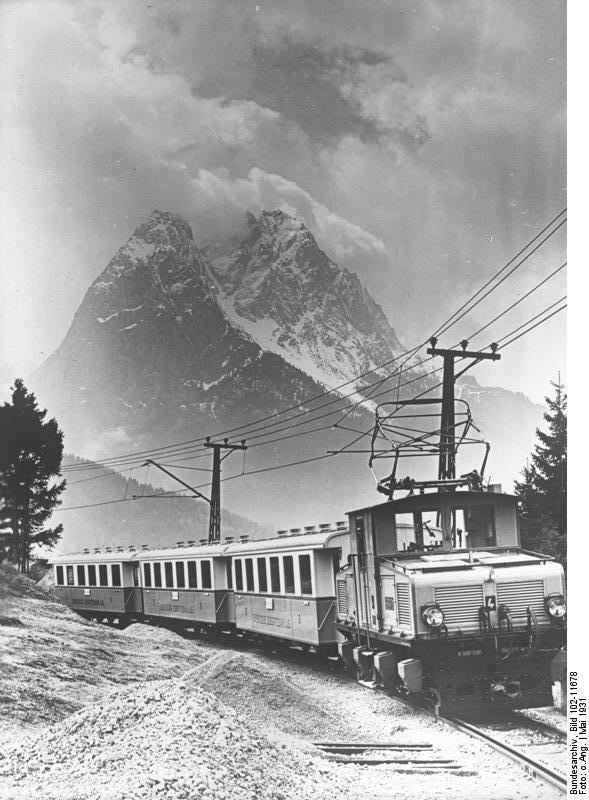Line number 9540 Rack system Riggenbach 0,0 Garmisch | Line length 19.0 km Maximum speed 70 km/h 1,2 Hausbergbahn | |
 | ||
The Bavarian Zugspitze Railway (German: Bayerische Zugspitzbahn) is one of four rack railways still working in Germany, along with the Wendelstein Railway, the Drachenfels Railway and the Stuttgart Rack Railway. The metre gauge line runs from Garmisch in the centre of Garmisch-Partenkirchen to the Zugspitze, the highest mountain in Germany. The line culminates at 2,650 metres above sea level, which makes it the highest railway in Germany and the third highest in Europe.
Contents
The line is operated by the Bayerischen Zugspitzbahn Bergbahn AG (BZB), whose majority owner is the Garmisch-Partenkirchen Municipal Works. In 2007 the Zugspitze Railway was nominated for a Historic landmarks of civil engineering in Germany award.
The Zugspitze is also accessible via the Eibsee Cable Car or Tyrolean Zugspitze Cable Car.
Opening of the line
The railway was built between 1928 and 1930 and opened in three stages. The first was the 3.2 kilometres (2.0 mi) long centre section between Grainau and the Eibsee which went into operation on 19 February 1929. On 19 December 1929 it was followed by the 7.5 kilometres (4.7 mi) long section between Garmisch and Grainau, including the important tourist connexion to the main railway network of the Deutsche Reichsbahn. On 8 July 1930 the last 7.9 kilometres (4.9 mi) long section between the Eibsee and the – now closed – summit station of Schneefernerhaus was opened, including the final 4,466 metres (14,652 ft) long Zugspitze Tunnel.
New summit section since 1987
In 1987 the route of the railway in the summit area was changed and the 975 metres (3,199 ft) long "Rosi Tunnel" opened. The tunnel was named after the skier, Rosi Mittermaier, who was the tunnel patroness (Tunnelpatin) at the time. The tunnel branches from the 1930-built Zugspitze Tunnel about three-quarters of the way along it, and runs to the somewhat lower Zugspitzplatt plateau at 2,588 metres (8,491 ft). Here, below the Sonn-Alpin Restaurant is the new Glacier Station (Gletscher-Bahnhof) in the middle of the ski area.
The overall length of the Zugspitze Railway was extended from 18.6 kilometres (11.6 mi) to its current 19.0 kilometres (11.8 mi). For five years, both termini were worked in parallel, but since November 1992 the old route to the Schneefernerhaus has no longer been routinely worked.
Route
The Zugspitze Railway starts in the quarter of Garmisch at a height of 705 metres (2,313 ft). Here the BZB runs its own terminal station which is operationally entirely separate from the adjacent standard gauge station of the Deutsche Bahn AG. Moreover, it is still just called Garmisch, whereas the DB station bears the double-barrelled name of Garmisch-Partenkirchen, reflecting the contentious merger, formally in 1935, of the two municipalities.
For the first 7.5 kilometres (4.7 mi), as far as Grainau, the Zugspitze Railway runs as an adhesion line. Of this section, the first 3 kilometres (1.9 mi) run parallel to the Ausserfern Railway, built in 1913. The mountain section begins in Grainau station, is equipped with a Riggenbach rack system, and is 11.5 kilometres (7.1 mi) long.
In former days there would be a change of engine in Grainau between the valley loco (Tallok) and the mountain loco (Berglok); today the railcars work the entire line. The railway climbs steeply uphill from Grainau, passes Eibsee station and finally arrives at the halt of Riffelriss. Immediately after the halt is the entrance to the Zugspitze Tunnel, which together with the Rosi Tunnel takes trains to the current terminus at Zugspitzplatt.
Technical
The Zugspitzbahn runs from Garmisch-Partenkirchen to Zugspitzplatt, a distance of 19.0 km. The track gauge is 1,000 mm and the electrification system is 1,500 V D.C.
